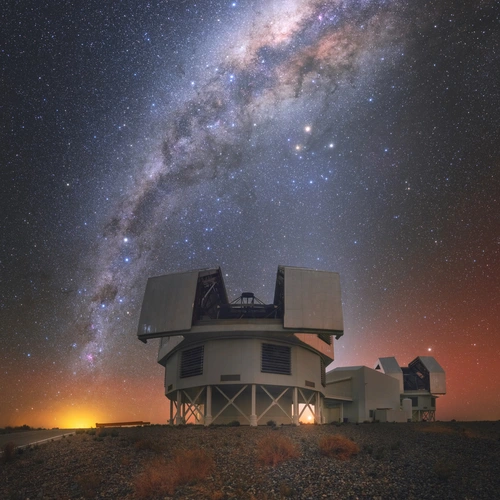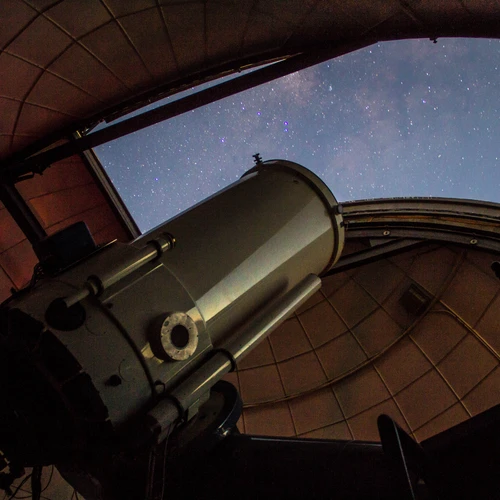Las Campanas Observatory
Carnegie Science's Las Campanas Observatory is known worldwide for the quality of its dark skies, which remain clear and stable due to its location above the Atacama Desert—the most arid non-polar place on the planet.
The observatory was established in 1969 as a home to both 40-inch and 100-inch reflecting telescopes. In the early 2000s, under the leadership of Carnegie Science President Emerita Maxine Singer, the twin 6.5-meter reflectors saw first light. These remarkable machines represent the latest generation of giant telescopes, enabling scientific breakthroughs across every specialty of astronomy and astrophysics.
The future of Las Campanas Observatory will be shaped by the construction of the Giant Magellan Telescope (GMT). This next-generation telescope is poised to transform the field of astronomy. From unveiling the intricate details of distant exoplanets to shedding light on the elusive nature of dark matter, the Giant Magellan Telescope promises a treasure trove of discoveries that will captivate stargazers and scientists alike.
Current Telescopes
The 6.5-meter Magellan Baade and Clay telescopes
The 2.5-meter Irénée du Pont telescope
The 1-meter Swope telescope
An ambitious new suite of telescopes.
Instruments in Development
The Commissioning Camera will capture the first multi-color images taken with the next-generation extremely large telescope—the Giant Magellan Telescope—when it goes live at Carnegie Science's Las Campanas Observatory. Once completed the Giant Magellan will enable astronomers to probe the universe with fresh eyes and the Commissioning Camera will play an integral role in its efforts. As well as being a critical tool for determining the telescope’s functionality, it will also enable science that ranges from studying the evolution of individual stars to providing insight on the structure and formation of the universe. Key scientific objectives for the instrument will include studying stellar populations in nearby galaxies and dwarf galaxies, the identification of distant clouds of gas and dust surrounding dying stars from which the subsequent generations of stars are born; young galaxies with intense star-forming activity, and black holes at the centers of galaxies.
Henrietta will expand our understanding of planets beyond our Solar System by detecting their atmospheres. Henrietta is designed to be the first ground-based spectrograph specifically designed to study exoplanet atmospheres in the near-infrared, where our eyes can't see. This wavelength range gives us critical insights into the chemical composition and physical processes that occur in exoplanet atmospheres. This instrument is named in honor of the esteemed astronomer Henrietta Hill Swope, who studied variable stars called Cepheids, which have a fixed relationship between their luminosity and their period, enabling astronomers to use them as distance calibrators.
Under development at the Carnegie Science Observatories, the Magellan Infrared Multi-object Spectrograph, or MIRMOS, will be a first-of-its-kind spectrograph built to excel at observing both faint objects, like distant galaxies, and bright sources, like stars hosting exoplanetary systems, in the infrared. Infrared light is key to many of the most active research topics in astrophysics, including the early universe’s first structures, the breakneck galaxy growth that occurred more than 10 billion years ago, and the atmospheres of distant exoplanets. Once installed on the Magellan telescopes at Las Campanas Observatory in Chile, MIRMOS will enable astronomers to answer fundamental questions about galaxy formation, including as how primordial galaxies changed their surroundings, whether a galaxy’s birthplace determines its destiny, and how galaxies grow within the enormous reservoirs of gas that comprise their cosmic ecosystems. It will also enable a novel census of exoplanetary atmospheres, which will be key to understanding the diversity and evolution of planetary systems beyond our own.
Falcon will be a multi-purpose, workhorse facility instrument for the 6.5-meter Magellan I Baade telescope at Carnegie's Las Campanas Observatory in Chile. It is designed to enable astronomical research across a variety of disciplines including, tomographically mapping the intergalactic medium at high redshift over a wide field, measuring stellar dynamical motions at high precision in nearby galaxies, and mapping and understanding the cycle by which matter is processed through galaxies and stars. A conceptual design is underway, with a goal to build Falcon at the Carnegie Science Observatories in Pasadena and install it at Magellan by the end of the decade. The project’s name comes from the layout of the instrument’s optics, which resemble a bird.
MagNIFIES, a powerful instrument set to be deployed on the Magellan Telescope at Carnegie Science’s Las Campanas Observatory in Chile will help usher in a new era of exploring distant worlds. Developed through a collaboration between Carnegie Science, UT Austin, the Korea Astronomy and Space Science Institute, and the Giant Magellan Organization, MagNIFIES is designed to reveal the chemical "fingerprints" within light from cosmic bodies, offering new insights into everything from the birth of stars to the atmospheres of distant planets. What sets MagNIFIES apart is its ability to simultaneously send light to six 25-megapixel detectors—each capturing a specific range of infrared light. This allows astronomers to capture the full range of infrared wavelengths—from 1.08 to 5 microns—in one shot. It will be up to 50 times faster than existing instruments. This leap in capability is enabled, in part, by Carnegie Science’s unique access to world-class telescopes like Magellan, allowing researchers to conduct cutting-edge observations with minimal delays. MagNIFIES will first be used on the Magellan Telescope, but it is ultimately destined for the Giant Magellan Telescope, where it will continue to push the boundaries of astronomical discovery.
Investigators from the Carnegie Science Observatories, the Center for Astrophysics | Harvard & Smithsonian, and Stanford University are preparing to use the entire Milky Way galaxy as a laboratory in order to probe and uncover the elusive nature of dark matter. The Milky Way is surrounded by more than a hundred stellar streams. These long, arcing bands of stellar material orbit our galaxy and its halo of dark matter. Impacts from small clusters of dark matter disperse stars out of these streams, and an exciting new initiative called the Via Project will search for the unique signatures of these disruptions in order to detect the otherwise invisible dark matter structures for the first time. To accomplish this thrilling goal, the Via Project team are designing and building two extremely sophisticated spectrographs, which will enable them to study the Milky Way's galactic halo at never-before-seen resolution. These precision instruments will be installed on telescopes in both hemispheres–the Magellan Clay at Carnegie Science’s Las Campanas Observatory in Chile and the MMT Observatory in Arizona.
More to Know
More details about our telescopes, our instruments, and other tools available to astronomers.
All the information observers need to prepare for their time using our telescopes.








